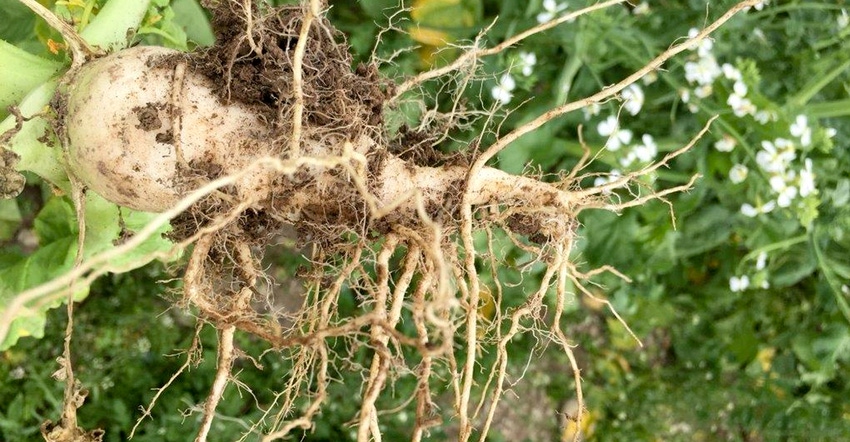March 6, 2017

You probably know about the Tillage Radish, the Ground Hog and maybe the Soil Buster and Sod Buster — daikon forage radishes used as cover crops. And as Steve Groff, Pennsylvania’s cover crop guru, predicts, more new and improved varieties are coming for different markets.
The Smart Radish, being developed Down Under in New Zealand, is one of them. It’s targeted for a fall 2018 seed sales launch, says Norwest Seeds’ Allan Lill, and it is likely to be in U.S. test trial plots this year.
Not all cover crop radishes perform well. Lesser performers tend to bolt early, have small tubers or both. Breeders evaluate plants’ root ground pressure, nutrient uptake, nematode suppression and fast growth — leaves and tubers.
“We believe the Smart Radish can achieve in one year what now takes two years with existing radishes,” contends Lill. It’s been bred to have a pull-down root/bulb and more lateral roots to help break up compacted soil. If it produces double the average aboveground vegetative growth, it’ll also have better weed suppression and produce more green manure or forage for grazing.
Shave seed bean costs
Speaking of smart, no smart farmer plants beans by the bag or bushel anymore. “Many producers are planting at a much higher rate than necessary,” suggests Shaun Casteel, Purdue University Extension soybean specialist.
What’s in Disease Shield corn
Dekalb’s “Disease Shield” moniker brings new genetics with superior resistance to key corn diseases — anthracnose stalk rot, Goss’s wilt, northern corn leaf blight and gray leaf spot. 2017 hybrids available range from 109 to 120 days maturity, reports Jared Webb, Dekalb product development manager.
Northern corn leaf blight tends to be a bigger issue in cooler summers. Gray leaf spot, favored by warmer moist conditions, was a big issue late in 2016 in some areas.
Carefully weigh corn fungicides
As many Northeast corn growers discovered last season, different diseases are more prevalent in certain growing conditions, reports Dave Nanda, president of Agronomic Crops Consultants LLC. Northern corn leaf blight likes cooler temperatures. Gray leaf spot likes high humidity and high temperatures. And conservation tillage has increased the incidence of many diseases.
Some popular corn hybrids have very high yield potential but are very susceptible to certain pathogens. And these hybrids help create more disease inocula for the following year since they’re grown on large acreages, he adds. So consider yourself forewarned and forearmed.
Slow-rusting wheat coming
Yet another biotech development promises to save wheat growers billions of dollars and reduce the need of costly fungicides to control three wheat rust pathogens and powdery mildew. The International Maize and Wheat Improvement Center has isolated the novel Lr67 wheat gene.
With climate change and more intensive cropping, new, highly virulent strains of fungi have been able to overcome the genetic resistance in today’s widely sown wheat varieties, says Ravi Singh, CIMMYT wheat breeder. The Lr67 genes slow — rather than totally stop — disease development. Combined with other such partial resistance genes through breeding, they may provide a strong, longer-lasting protection for plants, boosting food security.
The cloned Lr67 will be much easier to deploy widely in CIMMYT breeding lines, notes Singh. Varietal development efforts have progressed under the Borlaug Global Rust Initiative led by Cornell University and funded by the Bill and Melinda Gates Foundation and others.
Hans Braun, director of CIMMYT’s global wheat program, says wheats carrying this type of resistance would be ideal for organic farming. He foresees developing genetic “cassettes” carrying cloned versions of several slow-rusting, multiple disease-resistance genes, for easy insertion into wheat.
You May Also Like




